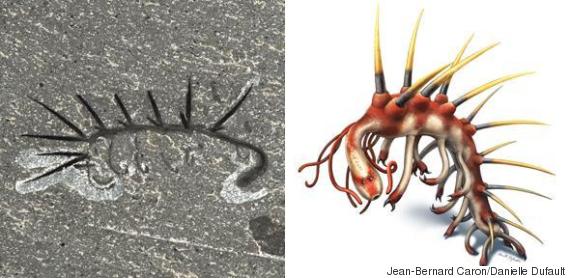Scientists Finally Figure Out Which End Of This Freaky 'Smiling' Worm Was The Head
Scientists have had a hard time figuring out the Hallucigenia worm that plied the oceans some 500 million years ago. Ever since the spindly-legged creature was first identified back in the 1970s, they've been baffled by its bizarre anatomy. No one could even tell which end of the worm was the head and which the tail.
But a new study of Hallucigenia fossils has revealed which end is which--and shed surprising new light on its primitive mouthparts.
"With the new description, you can imagine Hallucigenia looking a bit like a caterpillar but with really long, flimsy, extensible legs, and these pairs of conical spines running along its back," Dr. Martin Smith, a paleontologist at the University of Cambridge in England and the study's lead author, told Nature (see video above). "So it sort of looks like a twig with loads of sticks coming out of it."

For the study, the researchers used a micro-engraving tool to chip away at the shale of several dozen fossilized Hallucigenia specimens, Live Science reported. Then the researchers used an electron microscope to study the extinct species' eyes and mouth.
“We were not expecting at all to see the teeth smiling back at us under the microscope,” Smith told The Guardian.

Hallucigenia must have had a small mouth cavity in front of a ring of teeth to suck food into its throat, the analysis showed. And the throat would have been lined with tiny needlelike teeth to push the food into the stomach.
The fact that Hallucigenia had teeth at all came as a surprise, the researchers said. The modern-day velvet worms that descended from Hallucigenia have no teeth, so it had been assumed that their ancestors wouldn't have had teeth either.
“These teeth resemble those we see in many early moulting animals, suggesting that atooth-lined throat was present in a common ancestor,” study co-author Dr. Jean-Bernard Caron, curator of invertebrate palaeontology at the Royal Ontario Museumand associate professor at the University of Toronto in Canada, said in a written statement. “So where previously there was little reason to think that arthropod mouths had much in common with the mouths of animals such as penis worms,Hallucigenia tells us that arthropods and velvet worms did ancestrally have round-the-mouth plates and down-the-throat teeth--they just lost or simplified them later.”
The researchers hope to continue analyzing fossils to determine whether any match the features of a possible common ancestor.
The study was published online in the journal Nature on June 24, 2015.
| 




